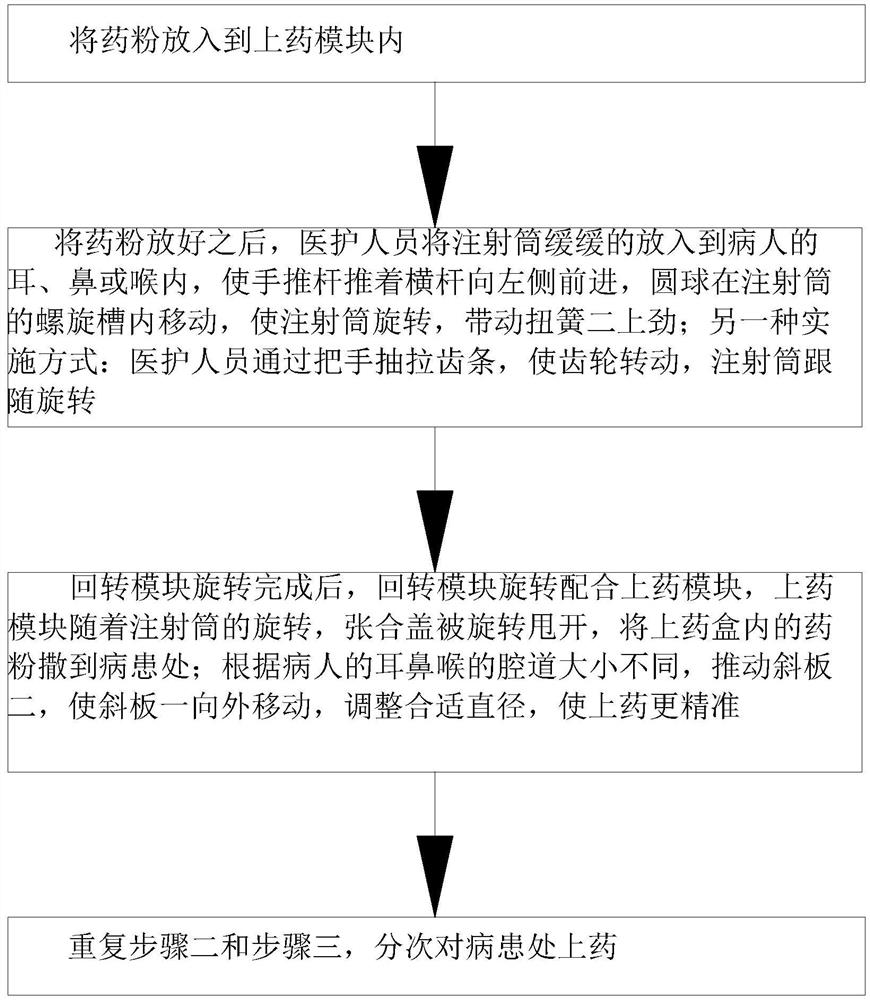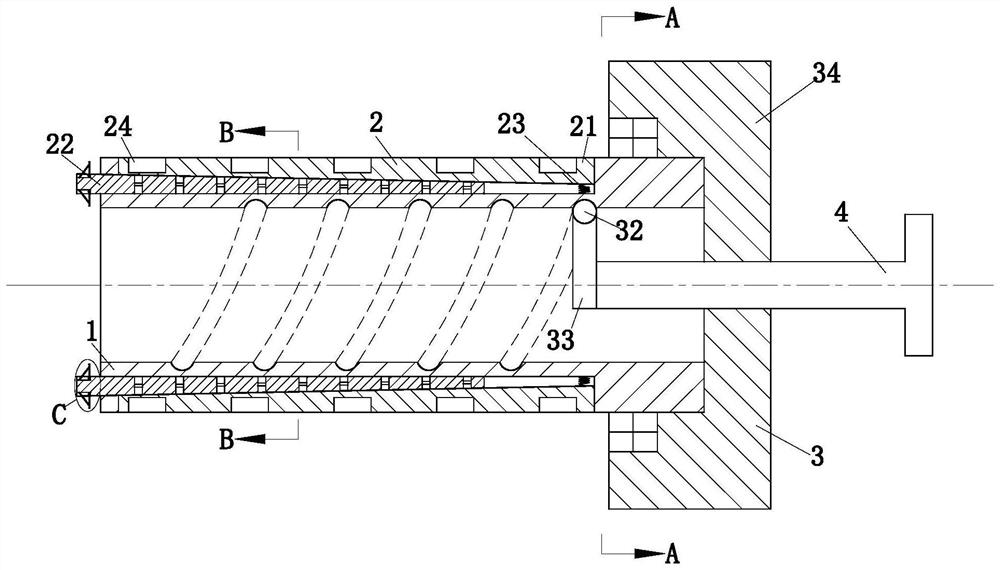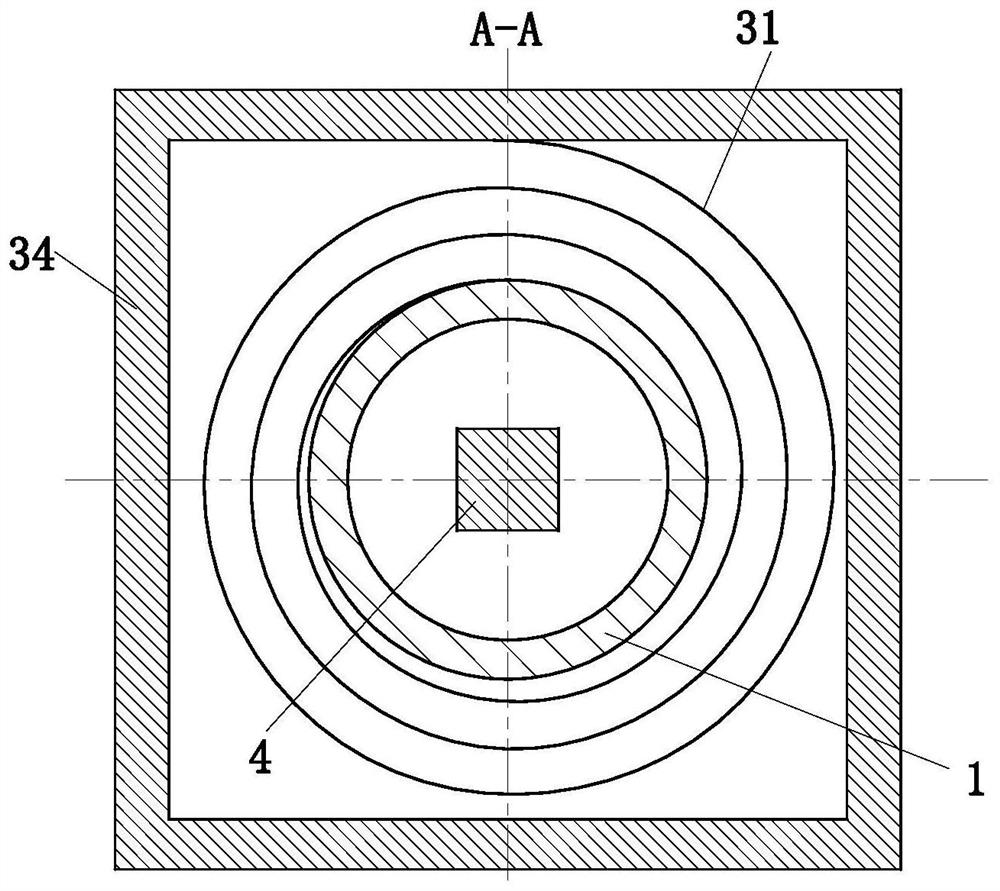Medicine applicator for ear, nose and throat patients
An ear, nose, throat and patient technology, applied in the field of medical devices, can solve the problems of increased workload of medical staff, inability to achieve uniform drug application, poor use effect, etc., and achieve uniform drug delivery, accelerated recovery, and uniform drug distribution.
- Summary
- Abstract
- Description
- Claims
- Application Information
AI Technical Summary
Problems solved by technology
Method used
Image
Examples
Embodiment approach
[0032] Step 2: After the traditional Chinese medicine powder is put away in step 1, the medical personnel slowly put the syringe 1 into the ear, nose or throat of the patient, and use the hand push rod 4 to push the cross bar 33 to the left, and the ball 32 Move in the spiral groove of the syringe 1 to rotate the syringe 1 and drive the torsion spring 2 31 to tighten; another embodiment: the medical staff pulls the rack 36 through the handle 37 to make the gear 35 rotate, and the syringe 1 rotates accordingly ;
[0033] Step 3: After the rotation of the rotary module 3 in the step 2 is completed, the rotary module 3 rotates to cooperate with the medicine-feeding module 2, and the medicine-feeding module 2 follows the rotation of the injection cylinder 1, and the opening and closing cover 25 is rotated and thrown away, and the medicine box 24 According to the size of the patient's ear, nose and throat cavity, push the inclined plate 22 to move the inclined plate 1 21 outward, a...
Embodiment 1
[0042] Embodiment 1: put the medicine powder into the medicine feeding module 2, slowly put the applicator into the ear, nose or throat of the patient, the medical staff pushes the hand push rod 4 to move, and the ball 32 is in the helical position of the syringe 1. Move in the groove to make the injection barrel 1 rotate, and drive the torsion spring 2 31 to push up. When the medical staff releases the hand push rod 4, hold the fixed plate 34, the torsion spring 2 31 makes the injection barrel 1 rotate, and the medicine feeding module 2 follows With the rotation of the injection cylinder 1, the opening and closing cover 25 is rotated and thrown away, and the powder in the upper medicine box 24 is sprinkled on the affected part; according to the different sizes of the patient's ear, nose and throat cavity, the inclined plate two 22 is pushed to make the inclined plate one 21 moves outward to adjust the appropriate diameter to make the medicine more accurate.
Embodiment 2
[0043] Embodiment 2: put the medicine powder into the medicine feeding module 2, slowly put the applicator into the ear, nose or throat of the patient, and the medical staff pull the rack 36 through the handle 37 to make the gear 35 rotate, and the injection barrel 1 follows the rotation, and the medicine feeding module 2 rotates with the rotation of the injection cylinder 1, and the opening and closing cover 25 is rotated and thrown away, and the medicine powder in the medicine box 24 is sprinkled on the affected part; Push the sloping plate 2 22 to move the sloping plate 1 21 outward, adjust the proper diameter, and make the medicine feeding more accurate.
PUM
 Login to View More
Login to View More Abstract
Description
Claims
Application Information
 Login to View More
Login to View More - R&D
- Intellectual Property
- Life Sciences
- Materials
- Tech Scout
- Unparalleled Data Quality
- Higher Quality Content
- 60% Fewer Hallucinations
Browse by: Latest US Patents, China's latest patents, Technical Efficacy Thesaurus, Application Domain, Technology Topic, Popular Technical Reports.
© 2025 PatSnap. All rights reserved.Legal|Privacy policy|Modern Slavery Act Transparency Statement|Sitemap|About US| Contact US: help@patsnap.com



